

SchoolHistory.co.uk - online history lessons, revision, games, worksheets, quizzes and links. HMH Current Events. On November 22, 1963, President Kennedy greets a crowd in the parking lot of the Texas Hotel, in Fort Worth just hours before his assassination.
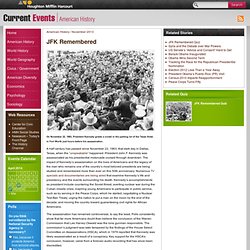
A half century has passed since November 22, 1963, that dark day in Dallas, Texas, when the “unspeakable” happened: President John F. Kennedy was assassinated as his presidential motorcade cruised through downtown. The impact of Kennedy’s assassination on the lives of Americans and the legacy of the man who remains one of the country’s most beloved presidents are being studied and remembered more than ever on this 50th anniversary. Numerous TV specials and documentaries are being aired that examine Kennedy’s life and presidency and the events surrounding his death.
The assassination has remained controversial, to say the least. A History (channel) documentary on the JFK assassination catalogs 311 distinct theories that together blame more than 40 groups and 200 individuals. Image credit: © Cecil Stoughton/John F. Related Links. HMH Holt McDougal Current Events. PearlHarbor.pdf. APUSH Homework Assignments Page. President John F. Kennedy - Life, Death, Legacy. Marking the 50th anniversary of the assassination of President John F.
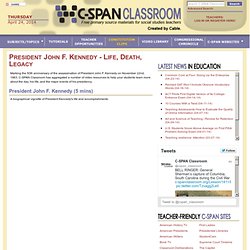
Kennedy on November 22nd, 1963, C-SPAN Classroom has aggregated a number of video resources to help your students learn more about the day, his life, and the major events of his presidency. President John F. Kennedy (5 mins) A biographical vignette of President Kennedy's life and accomplishments. President Kennedy's Inaugural Address (13 mins) Archival footage of President Kennedy’s speech delivered Friday, January 20, 1961. Bay of Pigs Invasion (10 mins) Freedom: A History of US. Webisode 1: Independence. Introduction. Or a century and a half Britain, the mother country, and the North American colonies, her children, were as close as a parent and children could be.

What happened to change that relationship? Perhaps the colonies outgrew childhood and wanted the independence that adults enjoy. The trouble began after the French and Indian War, which left Britain with tremendous debt. Why shouldn't the colonists pay some of that debt? To the colonists, the answer was easy: They shouldn't have to pay for it because they had no representation in the British Parliament that levied the taxes for the colonists to pay. To be subject to laws in which they had no voice amounted to tyranny. Parliament tried to tax sugar and tea. In 1775, Patrick Henry expressed the indignation of many who until this time considered themselves British subjects. That is exactly what the delegates to the Second Continental Congress did on July 4, 1776. In signing, they risked their lives and fortunes. United States History. • Skip Navigation • Skip to main content United States History Native Americans: Stereotypes and Assimilation Native American History: John Smith and the Powhatan Indian Removal.
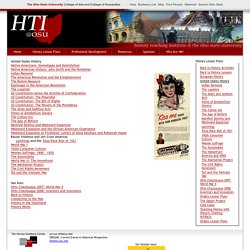
LIBERTY! . Road to Revolution Game. The American Revolution. American Revolution for Kids « History Matters: The U.S. Survey Course on the Web. LIBERTY! . Chronicle of the Revolution . Boston 1774. Hardliners in the British government, looking for reasons to clamp down on the Bay colony, found their cause last December when the Sons of Liberty made a salty Darjeeling of Boston Harbor. 342 crates of tea were dumped into the ocean in response to a parliamentary act which imposed restrictions on the purchase of tea in the colonies.

For his part, Franklin stood stoically through the ordeal, but was heard to mutter "I shall make your king a little man for this," to Wedderburn as both left the council at the end of the day. LIBERTY! . Perspectives . Military Perspectives. LIBERTY! . Chronicle of the Revolution . Timeline of the Revolution. Battle Joined A Push Toward Rebellion Americans Protest the Stamp Act Throwing British East India Company Tea into Boston Harbor LIBERTY! . Chronicle of the Revolution . Boston 1774.
"The Bostonians paying the excise-man, or tarring and feathering." A 1774 British print depicted the tarring and feathering of Boston Commissioner of Customs John Malcolm.
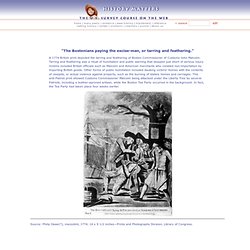
Tarring and feathering was a ritual of humiliation and public warning that stopped just short of serious injury. Victims included British officials such as Malcolm and American merchants who violated non-importation by importing British goods. Other forms of public humiliation included daubing victims’ homes with the contents of cesspits, or actual violence against property, such as the burning of stately homes and carriages.
This anti-Patriot print showed Customs Commissioner Malcolm being attacked under the Liberty Tree by several Patriots, including a leather-aproned artisan, while the Boston Tea Party occurred in the background. In fact, the Tea Party had taken place four weeks earlier. US History. Library - Gooru. National Atlas Home Page. The National Map is now offering a collection of small-scale datasets that can be downloaded for free.
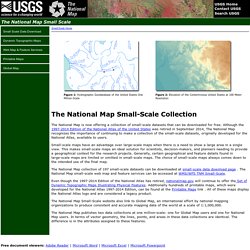
Although the 1997-2014 Edition of the National Atlas of the United States was retired in September 2014, The National Map recognizes the importance of continuing to make a collection of the small-scale datasets, originally developed for the National Atlas, available to users. Small-scale maps have an advantage over large-scale maps when there is a need to show a large area in a single view. This makes small-scale maps an ideal solution for scientists, decision-makers, and planners needing to provide a geographical context for the research projects. Generally, certain geographical and feature details found in large-scale maps are limited or omitted in small-scale maps. Freedom: A History of US. Tools & Activities. Games. Teaching American History Projects at CHNM. Learn about the U.S. Constitution, the Bill of Rights, the Declaration of Independence and much more! Civil War. Center on Congress.
Tracking the Buffalo. Civil War Terms and People. Primary Source Documents. For this entry, the previous subject matter was "Original Dictionaries of the 16th & 17th Centuries" and was linked to excellent work done at the University of Toronto. Time has marched on, links disappear. The works have matured and expanded.
Our original list was--; Lion (Lyon) Gardiner's legacy--; Diary of Lion Gardiner (1635) The Gardiner Family of Long Island - genealogy (1635) GARDINER, Lion -- American engineer (1635) United States History Map . Intro.